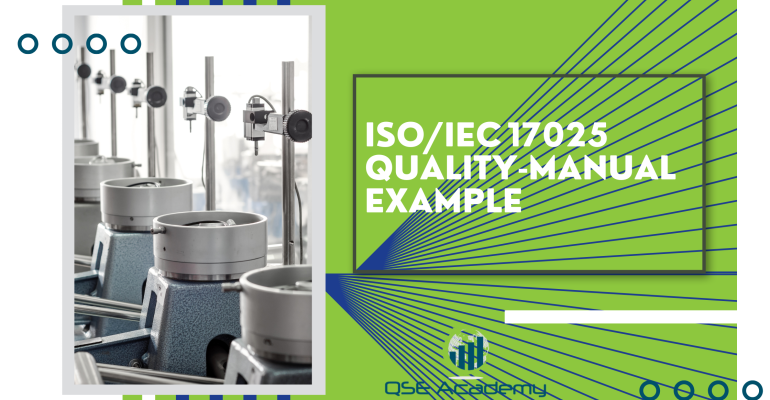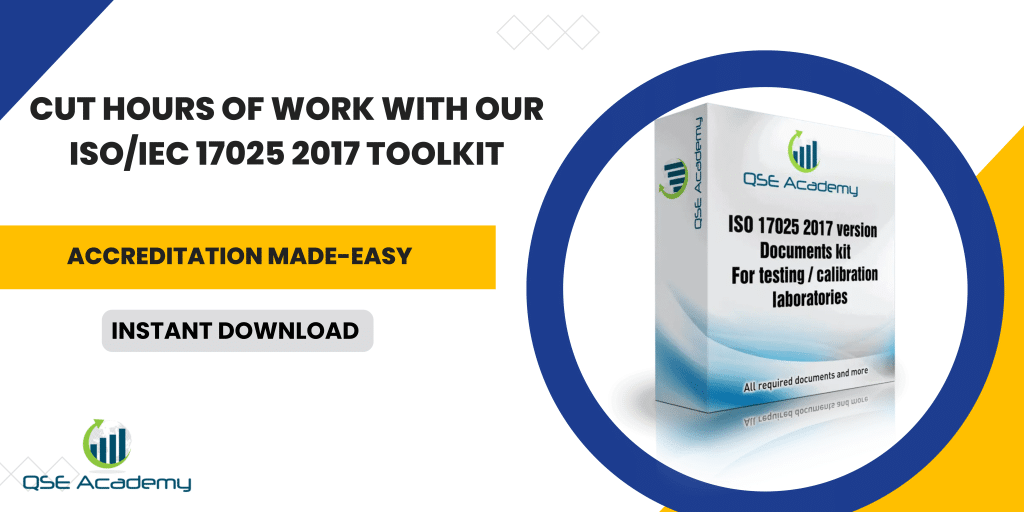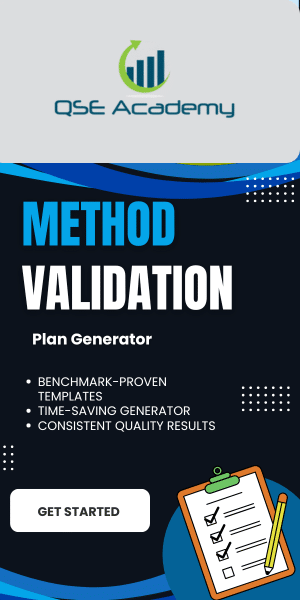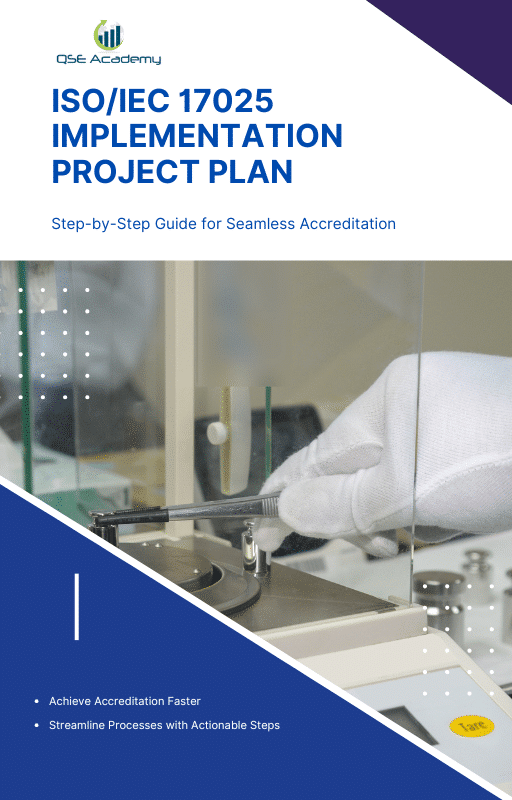ISO/IEC 17025 Quality‑Manual Example
Last Updated on October 13, 2025 by Melissa Lazaro
Understanding the ISO/IEC 17025 Quality Manual
If you’ve ever tried drafting a Quality Manual for your lab, you’ve probably wondered, “Do we still need one under ISO/IEC 17025:2017?” You’re not alone.
I’ve helped dozens of testing and calibration labs build or refresh their systems, and that question comes up in every single project. The truth? The 2017 version of the standard no longer requires a formal Quality Manual — but the best-run labs still keep one. Why? Because it’s the single document that connects the dots between your people, your processes, and the clauses of the standard.
Think of it as your lab’s “user manual.” When written well, it gives everyone — from new hires to auditors — a clear picture of how your system actually works. It’s not just about compliance; it’s about clarity and confidence.
In this article, we’ll walk through:
-
What an ISO/IEC 17025 Quality Manual really is (and what it isn’t)
-
The exact structure you can follow
-
Practical writing tips from real audit experiences
-
A few sample excerpts you can model yours after
By the end, you’ll have a working framework you can tailor to your own lab — something lean, logical, and audit-ready.
Now, let’s start by clearing up the biggest misconception: Is a Quality Manual still necessary?
What Is an ISO/IEC 17025 Quality Manual (and Do You Still Need One?)
Here’s the truth — the 2017 version of ISO/IEC 17025 removed the explicit requirement for a Quality Manual.
But if you walk into any accredited lab today, you’ll still find one sitting on the Quality Manager’s desk or uploaded to their document control system. Why? Because it’s still one of the most practical tools you can have.
Let’s get this straight: a Quality Manual isn’t just a formality. It’s your roadmap — the one document that explains how your management system ties together. It connects every clause of ISO/IEC 17025 to the real processes and people in your lab.
Here’s what I’ve noticed:
Labs that skip the manual often end up with scattered procedures, duplicated efforts, and confused auditors. Labs that keep one — even a concise, well-structured version — breeze through audits because everything is linked, consistent, and easy to find.
So what’s the purpose today?
-
It helps your team understand how your management system works without flipping through a dozen procedures.
-
It provides auditors with a quick overview of how your lab meets each requirement.
-
It keeps your system consistent as your lab grows, adds new methods, or changes staff.
Pro Tip:
Think of your Quality Manual as the “table of contents” for your entire system. It doesn’t need to repeat every policy or procedure — it just needs to explain where they are and how they fit together.
Common Mistake:
Copying ISO 17025 clauses word-for-word. That’s not a Quality Manual; that’s plagiarism.
Your manual should describe your lab’s way of meeting those clauses — in plain, specific language.
Now that we know why the Quality Manual still matters, let’s look at what it actually includes — section by section.
Typical Structure of an ISO/IEC 17025 Quality Manual
Now that you know why the Quality Manual still matters, let’s break down what it should actually look like.
I’ve seen everything from 100-page monsters that no one reads to 8-page manuals that work beautifully. The difference? The good ones are structured for clarity, not formality. They’re written for people — not auditors.
Here’s the layout I recommend and use with every client lab I help implement ISO/IEC 17025:
1. Title Page and Control Information
Start simple — include the document title (“Quality Manual”), your lab’s name, version number, approval signature, and revision history.
This shows auditors your document is controlled and actively maintained.
Pro Tip: Add a short statement like,
“This manual is controlled electronically. Printed copies are considered uncontrolled.”
That one line has saved many clients from audit findings.
2. Scope and Application
Define what your lab actually does.
Which activities fall under your accreditation? Testing? Calibration? Both?
Be specific about your services, locations, and any exclusions.
Example:
“This manual applies to all calibration activities performed at QSE Calibration Laboratory, including temperature, pressure, and mass calibration services.”
3. Normative References and Definitions
List the standards or documents your lab refers to — like ISO/IEC 17025:2017, ISO 9001, or your national accreditation body requirements.
Keep this section short and clean.
4. Management System Overview
Summarize how your management system fulfills Clauses 8.1–8.9 of ISO/IEC 17025.
This section links your procedures, forms, and policies together.
Pro Tip:
Add a table that cross-references each ISO clause with your corresponding procedure or record — it’s one of auditors’ favorite features.
5. Organization and Responsibilities
Show your structure and who does what. Include:
-
An organizational chart
-
Defined responsibilities for top management, the quality manager, and technical personnel
Keep it visual — a clear chart tells the story better than paragraphs ever could.
6. Resource Management (Clause 6)
Summarize how your lab ensures competence, suitable facilities, and properly maintained equipment.
You can reference your detailed procedures here (like your Equipment Control or Training procedure).
7. Testing and Calibration Processes (Clause 7)
Outline your core process flow:
From request → method selection → testing/calibration → data recording → reporting results.
This section shows you understand and control the workflow that produces valid results.
8. Document Control and Record Management
Briefly describe how your lab creates, approves, and maintains controlled documents and records.
Link to your Document Control Procedure — don’t repeat it.
9. Internal Audits, Corrective Actions, and Improvements
Show how you monitor your system’s effectiveness.
Mention audit schedules, management reviews, and continual improvement steps.
10. Annexes and Supporting Documents
Use this space for your procedure index, calibration certificates, forms, or clause mapping tables.
It’s your “quick reference” section for auditors.
Pro Tip:
Use hyperlinks in your digital manual so anyone can jump straight from the manual to the relevant procedure or form.
It saves time, reduces confusion, and keeps everything connected.
How to Write an Effective ISO/IEC 17025 Quality Manual
Writing your Quality Manual isn’t about copying text from the ISO standard — it’s about describing your lab’s way of meeting the requirements.
Think of it as storytelling for your management system: you’re explaining how everything works together, clearly and confidently.
When I guide labs through this step, I always say:
“If your technicians can’t understand your manual, it’s not working — no matter how pretty it looks.”
Let’s make sure yours actually works.
Start with Plain Language
Avoid “ISO speak.” Write the way your team talks in real life — clear, short sentences, and no unnecessary jargon.
Instead of writing:
“The laboratory shall ensure the competence of personnel conducting specific laboratory activities.”
Try this:
“The Technical Manager authorizes staff to perform testing after their competence is evaluated using the Competence Matrix (Form QF-06).”
Auditors prefer manuals that sound human. So do your staff.
Be Clause-Linked, Not Clause-Copied
A good manual references ISO/IEC 17025 clauses — it doesn’t repeat them.
Create a small cross-reference table (Clause → Procedure → Record). It helps anyone reading your manual understand how compliance is achieved, without pages of duplication.
Pro Tip:
When you describe a process, mention how it connects to other procedures. For example:
“Equipment calibration is controlled as per Procedure QP-07. Records of all calibrations are maintained in Form QF-12.”
It’s short, traceable, and clear.
Keep Each Section Purpose-Driven
Each section should answer one question: How does the lab ensure this part of the standard is met?
-
If you’re describing management review — explain who leads it, what data is reviewed, and how actions are tracked.
-
If you’re describing competence — state who evaluates, how training is documented, and how re-authorization happens.
No filler, no copy-paste, no fluff.
Balance Detail with Simplicity
A manual is a high-level guide — not a collection of step-by-step procedures.
Keep it short, and use hyperlinks or references to detailed SOPs.
Pro Tip:
Aim for 15–25 pages max. If it’s longer, you’ve probably included content that belongs in your procedures instead.
Make It Look Professional, Not Overdesigned
Use consistent formatting:
-
Header with section title and clause reference
-
Footer with version number and date
-
Simple font, clean spacing, and logical numbering
Common Mistake:
Labs sometimes design manuals like marketing brochures — full of logos, colors, and graphics. That’s distracting. Your Quality Manual isn’t a flyer; it’s a functional document.
Example Excerpts: Quality Manual in Practice
Let’s make this real.
It’s one thing to talk about how to structure or write a Quality Manual — it’s another to see how it sounds in practice. Over the years, I’ve helped many labs turn their manuals from jargon-heavy PDFs into clear, functional guides that both staff and auditors actually understand.
Here are a few sample excerpts you can model your own on.
Example 1 – Scope
Section 1.0: Scope
This Quality Manual applies to all testing and calibration activities conducted by QSE Analytical Laboratory at its main facility in Manila, Philippines.The laboratory provides calibration services in temperature, pressure, and mass measurements, and testing services in environmental and chemical analysis.
All laboratory work is performed in compliance with ISO/IEC 17025:2017 and in accordance with customer and regulatory requirements.
Why this works:
It’s clear, specific, and directly states what’s covered. No extra words, no vague phrasing. Auditors love that.
Example 2 – Document Control
Section 8.3: Control of Documents
All controlled documents, including this Quality Manual, are reviewed and approved by the Quality Manager prior to issue.
Document control is managed electronically through the “QMS Document Register.” Obsolete versions are removed from circulation immediately and archived digitally for recordkeeping.
Only the latest approved version is available to staff through the shared quality management folder.
Pro Tip:
You don’t need to repeat every detail of your Document Control Procedure — just summarize how it’s applied. Reference the full procedure by code or title.
Example 3 – Management Review
Section 8.9: Management Review
The Laboratory Director conducts a management review annually to ensure the continuing suitability, adequacy, and effectiveness of the management system.
The review includes:
Results of internal and external audits
Nonconformities and corrective actions
Feedback from clients
Performance against quality objectives
Resource and improvement needs
Review outcomes are documented in the Management Review Minutes (Form QF-25), and follow-up actions are tracked by the Quality Manager.
Why this works:
It shows leadership involvement, clear responsibilities, and real process control — exactly what auditors are looking for.
Example 4 – Organizational Structure
Section 5.0: Organization and Responsibilities
The laboratory’s organizational structure ensures impartiality and effective management of testing and calibration activities.
The Quality Manager reports directly to the Laboratory Director and has the authority to stop work that affects quality or impartiality.
An organizational chart (Annex A) identifies reporting lines and areas of responsibility for all technical and support staff.
Pro Tip:
Never underestimate how powerful a simple org chart is. It instantly clarifies accountability — no explanation needed.
Integrating Your Quality Manual with Other Documents
Here’s something I tell every lab client during implementation:
“Your Quality Manual isn’t a standalone document — it’s the backbone that holds your system together.”
When your manual works hand-in-hand with your procedures, forms, and records, everything runs smoother — audits, training, and daily operations included.
Let’s talk about how to make that happen without turning your documentation into a tangled mess.
Understand the Documentation Hierarchy
Think of your documentation system as a simple pyramid:
Top layer: Quality Manual →
Middle layer: Procedures & SOPs →
Bottom layer: Forms & Records
Each layer has its own purpose:
-
The Quality Manual explains what you do and how the system fits together.
-
Procedures and SOPs describe how specific tasks are carried out.
-
Forms and Records show proof that those tasks were done correctly.
Pro Tip:
Reference upward, not downward.
For example, your calibration SOP should point back to the Quality Manual — not the other way around. That keeps your manual clean and high-level.
Use Cross-References Instead of Repetition
Avoid repeating the same content in multiple places. Instead, link documents logically.
Example:
“Document control is implemented according to Procedure QP-04. Record retention is defined in QP-05.”
This method keeps updates simple — when something changes in a procedure, you don’t have to hunt through your manual to fix it too.
Auditors and staff shouldn’t need to dig through folders to find what they need.
Whether you use a shared drive, a document management system, or a simple cloud folder, make navigation intuitive.
Here’s what works well:
-
A “Read Me First” page that explains how to use the manual
-
A linked index or “clause map” that jumps straight to relevant documents
-
Consistent file naming (e.g., “QP-07 Equipment Control Procedure,” “QF-12 Calibration Record”)
Pro Tip:
Keep everything in one main location — not spread across emails, desktops, or multiple drives. Consistency is half the battle.
Link to Your Quality Policy and Objectives
Your Quality Manual should clearly reference the lab’s Quality Policy and objectives.
This shows how management commitment flows through every part of the system — from leadership to the bench.
Example:
“This manual supports the Quality Policy (QP-00), which commits the laboratory to impartiality, competence, and continual improvement in accordance with ISO/IEC 17025:2017.”
Avoid Common Pitfalls
-
Too much duplication: You don’t need to copy every clause or procedure.
-
Broken links or outdated references: Review them at least twice a year.
-
Overcomplicated navigation: Fancy systems fail if your team can’t use them.
Maintaining and Updating Your Quality Manual
Here’s the thing about ISO/IEC 17025 systems — they’re not “write it once and forget it.”
Your Quality Manual is a living document. It should evolve as your lab does.
Every time you add a new service, hire new technical staff, or upgrade equipment, your system shifts — and your manual should reflect that.
In my experience, this is where many labs slip up. They spend months crafting the perfect manual, get accredited, then let it gather digital dust for years. The result? When renewal time comes, the manual no longer matches reality — and auditors catch it immediately.
Let’s make sure that doesn’t happen to you.
Keep Revision Control Tight
Every version of your manual should have clear revision information:
-
Revision number (e.g., Rev 03)
-
Date issued
-
Brief description of changes
-
Approval signature
Pro Tip:
Add a simple revision table on the last page. It keeps everything transparent and makes audits smoother.
Example:
| Rev | Date | Description of Change | Approved By |
|---|---|---|---|
| 1 | Jan 2023 | Initial release | Lab Director |
| 2 | Oct 2024 | Updated organization chart and scope | Quality Manager |
| 3 | May 2025 | Added subcontractor approval procedure | Quality Manager |
This one-page summary shows control, traceability, and commitment to continual improvement.
Set a Review Frequency
Even if nothing major changes, schedule a review — at least annually.
The easiest way? Tie it to your management review cycle. That way, every year you’re already discussing performance, resources, and improvement actions — and can confirm your manual still reflects the lab’s operations.
Pro Tip:
If you note “Reviewed – no changes required” in your revision table, you’re still demonstrating control. It shows you checked, even if updates weren’t needed.
Update When Your System Changes
You don’t have to rewrite your manual for every tiny edit, but you should update it when:
-
You add or remove testing/calibration services
-
You restructure roles or reporting lines
-
You change facilities or major equipment
-
You revise core procedures or policies
When in doubt, ask: “Would this change affect how we describe our management system?” If yes — update the manual.
Communicate Updates
Once revisions are approved, make sure staff actually know.
Send an internal memo, highlight updates in a team meeting, or use a simple “What’s New” section in your document control system.
What doesn’t work:
Updating the file quietly and expecting everyone to notice. They won’t — and during audits, that shows up as a “lack of awareness.”
Common Pitfalls to Avoid
-
Version chaos: Multiple copies floating around in different folders.
-
Outdated references: Old procedure codes or contact names that no longer exist.
-
Neglecting linkage: Forgetting to update references when a related procedure changes.
FAQs: Common Questions About ISO/IEC 17025 Quality Manuals
Even with a solid structure and examples in hand, certain questions always come up — especially when labs start drafting or updating their manual for the first time.
Let’s tackle the ones I get most often when consulting with testing and calibration facilities.
1. Is the Quality Manual still mandatory under ISO/IEC 17025:2017?
Technically, no.
The 2017 version dropped the explicit requirement for a Quality Manual.
But in practice? Almost every accredited lab still keeps one — and for good reason.
It gives your staff and auditors a clear, top-level overview of your management system. Without it, people spend hours digging through procedures to figure out how things connect.
Pro Tip:
Think of the manual as your lab’s storybook — short, clear, and showing how everything fits together. It’s not a requirement on paper, but it’s indispensable in reality.
2. How long should my Quality Manual be?
There’s no rule. But from experience, a concise manual (15–25 pages) works best.
Longer ones usually repeat content that belongs in procedures.
Remember: your manual should summarize — not reprint — your entire system.
Example:
One calibration lab I helped used a 12-page manual that mapped every ISO clause to their processes and forms. The auditor said it was the clearest she’d seen in months.
Common Mistake:
Writing a 70-page “monster manual.” Nobody reads it, and it quickly goes out of date.
3. Can we combine the Quality Manual and the Quality Policy?
Yes — as long as it’s clear where one ends and the other begins.
Many small labs do this to keep their documentation simple.
Just make sure your Quality Policy still appears as a distinct, approved statement from top management.
Pro Tip:
Use formatting to separate them — for example, include your Quality Policy as the first page of the manual with a signature block and date, then continue with the rest of the sections.
4. Do we need separate manuals for testing and calibration?
Not necessarily.
If both activities share the same management system, one manual is enough.
You can simply define separate scopes or appendices that specify the differences in testing versus calibration processes.
Pro Tip:
Keep the shared elements (like document control, audits, and training) unified, and specify only where processes differ.
Building a Quality Manual That Works for Your Lab
By now, you can probably see that a great Quality Manual isn’t about perfection — it’s about practicality.
It doesn’t need to impress with length or big words; it just needs to reflect how your lab actually works and prove that your system is under control.
In my experience, the best manuals share three traits:
-
They’re clear. Anyone in the lab — from the director to a new technician — can read them and understand how things connect.
-
They’re consistent. The manual matches what’s really happening on the floor. No mixed messages, no “ghost documents.”
-
They’re alive. The manual grows with the lab — updated when people, methods, or equipment change.
That’s what accreditation bodies look for: evidence of control, not paperwork for paperwork’s sake.
Key Takeaways
-
The ISO/IEC 17025:2017 version may not demand a Quality Manual, but having one makes your system stronger, clearer, and easier to audit.
-
Keep it short and functional — about 15–25 pages is usually enough.
-
Cross-reference your procedures and records so everything connects logically.
-
Review and update it regularly to reflect how your lab actually operates.
A Final Word from Experience
After years helping laboratories across industries — from calibration shops to environmental test labs — I’ve seen one pattern: those who treat their Quality Manual as a living tool, not a static document, perform better in audits and daily operations alike.
It’s not about passing once — it’s about staying confident, compliant, and competent year after year.
Next Step: Simplify Your Documentation
If you’re building your ISO/IEC 17025 system from scratch or refreshing an outdated manual, don’t start from zero.
QSE Academy offers a Complete ISO/IEC 17025 Documentation Package — including a ready-to-edit Quality Manual, procedures, and forms — all aligned with the latest version of the standard.
And if your lab needs something tailored, our consultants can craft a customized Quality Manual designed around your exact operations and scope.
Your Quality Manual should work for you — not against you.
Start with structure, keep it simple, and build a system your entire team can stand behind.
I hold a Master’s degree in Quality Management, and I’ve built my career specializing in the ISO/IEC 17000 series standards, including ISO/IEC 17025, ISO 15189, ISO/IEC 17020, and ISO/IEC 17065. My background includes hands-on experience in accreditation preparation, documentation development, and internal auditing for laboratories and certification bodies. I’ve worked closely with teams in testing, calibration, inspection, and medical laboratories, helping them achieve and maintain compliance with international accreditation requirements. I’ve also received professional training in internal audits for ISO/IEC 17025 and ISO 15189, with practical involvement in managing nonconformities, improving quality systems, and aligning operations with standard requirements. At QSE Academy, I contribute technical content that turns complex accreditation standards into practical, step-by-step guidance for labs and assessors around the world. I’m passionate about supporting quality-driven organizations and making the path to accreditation clear, structured, and achievable.












